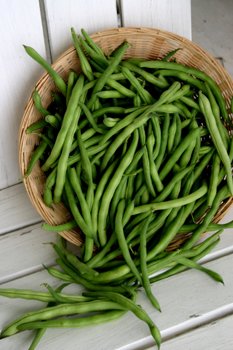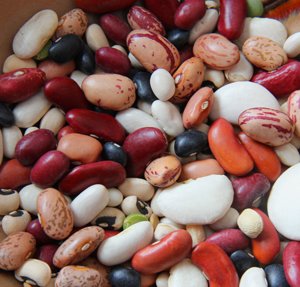





Beginnings are often fascinating. Looking into the origins and history of our common everyday fruits and vegetables is often eye-opening and a great read.
Beans have been used by humans around the world for thousands of years. From chickpeas in the Middle East, to soybeans in Asia, to lima beans and kidney beans in the New World, we have a wealth of legumes to enjoy. Beans were known and used by Europeans when Columbus made his voyages, but near what we now know as Cuba, he still noted on November 4th, 1492 that “they have faxones and fabas different from ours.” This was the Phaseolus vulgaris, or 'common bean' and he brought samples back across the Atlantic with him.
 New World beans were quickly added to the diets of Europeans, however, as with their local cousins, nobility deemed them too mundane for their more cultured taste buds. Commoners, however embraced the new beans and often they were one of their only sources of protein. Since the kings and nobles owned the forests and fields, which included the deer, rabbits, partridges and squirrels, it was upon penalty of death to poach one of the local lord's creatures and peasants depended on their kitchen gardens for sustenance,
New World beans were quickly added to the diets of Europeans, however, as with their local cousins, nobility deemed them too mundane for their more cultured taste buds. Commoners, however embraced the new beans and often they were one of their only sources of protein. Since the kings and nobles owned the forests and fields, which included the deer, rabbits, partridges and squirrels, it was upon penalty of death to poach one of the local lord's creatures and peasants depended on their kitchen gardens for sustenance,
It seems that there are a number of legends and beliefs associated with beans and the natives of the New World worshiped the bean as much as they did corn. It is ironic that the two life-giving foods needed each other to form a perfect protein. The amino acids that beans are lacking, the corn provides. And the beans provide what the corn is missing. The custom of eating a grain with a bean may be considered 'po-folks food', but dishes such as red beans and rice or white beans and cornbread are actually complete proteins, rich in fiber and other health benefits.
People often complain that beans make them gassy, but this is just a temporary adjustment and your body should regulate itself in a few weeks with regular bean consumption. It is interesting to note that the ancient Pythagoreans believed that people should avoid eating beans because the gasses released from the intestines (farts) were their souls! As smart as Pythagoras was mathematically, he was completely wrong in this case. Beans are a significant source of fiber which in turn, helps flush the body of cholesterol and regulates blood sugar. And as we all know, those are two things that modern man badly needs in his diet. Black beans are even more important, containing an indigestible fraction that helps the bacteria in the colon produce butryic acid. This substance slows the absorption of sugar into the body and also helps prevent cancer with the high phytonutrient content just like brightly colored fruits and vegetables.
 Plant beans after all chance of frost has passed in a part of your garden that receives full sun. Go easy on the fertilizer, especially nitrogen. High nitrogen levels will produce lush foliage, but few beans. Bush beans do not need support, but they are usually the type that sets most of the beans at the same time and the bulk of the harvest matures at the together. If you plant bush beans, do so in 2 week intervals to ensure a fresh harvest throughout the summer. Pole beans produce long vines and require support. Old fashioned cane poles are the traditional way of staking them, however they can be encouraged to twine on fences, cattle panels and even decorative trellises. The pole beans bloom and set pods all season, so there is a constant harvest. In both cases, pick the immature beans before the pods swell for green bean use, or allow the pods to dry on the vines for dried beans.
Plant beans after all chance of frost has passed in a part of your garden that receives full sun. Go easy on the fertilizer, especially nitrogen. High nitrogen levels will produce lush foliage, but few beans. Bush beans do not need support, but they are usually the type that sets most of the beans at the same time and the bulk of the harvest matures at the together. If you plant bush beans, do so in 2 week intervals to ensure a fresh harvest throughout the summer. Pole beans produce long vines and require support. Old fashioned cane poles are the traditional way of staking them, however they can be encouraged to twine on fences, cattle panels and even decorative trellises. The pole beans bloom and set pods all season, so there is a constant harvest. In both cases, pick the immature beans before the pods swell for green bean use, or allow the pods to dry on the vines for dried beans.
I let my dry beans air for another week or two after harvest in flat pans before sealing them in containers. (plastic ice cream buckets work great) I also put the containers in the freezer. That way, any insects are killed. When I need beans, I just move a bucket into the pantry and scoop as the recipe indicates.
There are thousands of bean cultivars and we have many participating vendors offering a wide range of choices. So try something different this year and surprise your family with a new variety. From beautiful heirlooms to trusty, heavy yielding hybrids there's sure to be some that fits your family's taste buds.
Copyright © www.100flowers.win Botanic Garden All Rights Reserved